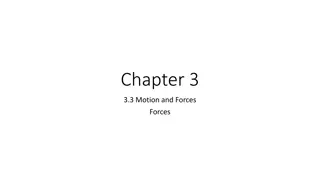Understanding Forces in Motion
Exploring the concept of forces in motion, this educational material delves into why moving objects slow down and eventually stop. Through various images and questions, students are encouraged to think about the forces acting on objects like soccer balls and understand the impact of surfaces on motion. Key questions address why objects start moving, stop, or change direction, prompting critical thinking in the realm of physics.
Download Presentation

Please find below an Image/Link to download the presentation.
The content on the website is provided AS IS for your information and personal use only. It may not be sold, licensed, or shared on other websites without obtaining consent from the author. Download presentation by click this link. If you encounter any issues during the download, it is possible that the publisher has removed the file from their server.
E N D
Presentation Transcript
FORCES LESSON 3A Why Do Moving Objects Slow Down and Eventually Stop?
Review: Representing Forces What two things do arrows show about a force acting on an object?
What Are the Forces? What arrows would you draw to represent the forces acting on the soccer ball as it moves down the field? Courtesy of BSCS
What Are the Forces? What arrows would you draw to represent the forces necessary to score a goal? What object is being pushed or pulled? What object is exerting a force? What is the direction of each arrow that represents a force acting on an object? What is the length of each arrow? What does the length of each arrow represent?
What Are the Forces? What arrows would you draw to represent the forces necessary to score a goal? Courtesy of BSCS
Unit Central Questions What makes something start to move? What makes something stop moving or change direction?
Todays Focus Question Why do moving objects slow down and eventually stop?
Why Do Moving Objects Stop? If you kick a soccer ball on a field, why do you think the ball will eventually stop?
Why Do Moving Objects Stop? Complete this sentence in your science notebook: I think the soccer ball I kick on a field will eventually stop because _______.
Investigation: Does the Surface Matter? Think about this scenario: Students rolled a soccer ball over three different surfaces: Grass Blacktop on the playground Tile flooring in the school hallway The students tried to use the same force each time. Then they measured how far the ball rolled. Question: Do you think the ball traveled the same distance on all three surfaces? Why or why not?
Investigation: Does the Surface Matter? Carpet Car Ramp Meter Stick Photo courtesy of BSCS
Make Your Predictions Read about the investigation at the top of the handout (Does the Surface Matter?). Then answer the questions: Do you think the car will travel the same distance over all three surfaces? Why do you think this will or won t happen? Photo courtesy of BSCS
Share Your Predictions Will the car travel the same distance over all three surfaces? Why do you think this will or won t happen? Share your prediction with an elbow partner. If you revise your prediction, don t erase your original ideas. Just lightly cross through it and write your new ideas in a different color underneath or on the back of your handout.
Lets Summarize! Our focus question: Why do moving objects slow down and eventually stop? Earlier today you completed this sentence: I think the soccer ball I kick on a field will eventually stop because _____________. Find this sentence in your notebook and revise it based on the ideas we explored today.
Next Time Today we predicted whether a toy car rolling down a ramp will travel the same distance over three different surfaces. Next time, we ll test our predictions and collect some data to help us figure out why moving objects slow down and eventually stop.























